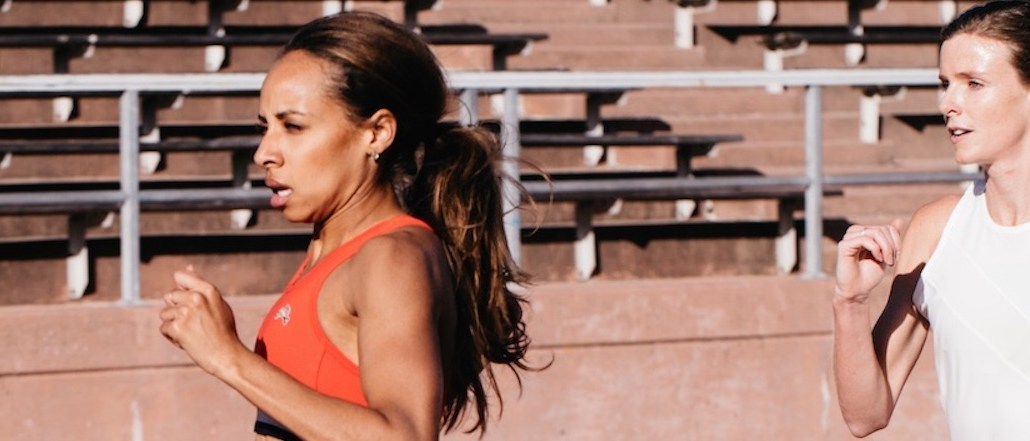
This story was first published on Glossy, Digiday Media’s new publication devoted to how technology is changing the fashion and luxury industries.
The U.S. is in the midst of its second running boom, a movement that has made the sport more democratic and participatory. But for many old-school, serious runners, something’s been lost in the process. They tend to see their sport, predicated on hard miles, diluted from its roots, lost amidst costumed races and big expos.
That’s the niche focus of Tracksmith, a 2-year-old Boston-based running apparel company that proudly bills itself as “style and culture for the competitive runner.” It wants to craft high-end performance apparel for the serious runner who sees the sport as a lifestyle, not unlike how wine lovers make touring wineries part of their lives.
The company very consciously evokes that 1970s aesthetic, reminiscent of the running boom of that period. So, the shorts are short and work for a quick dip in the lake during a long run just as well as for logging miles on trails. There is no neon, and there are no patterns. There is definitely no mesh. All that’s missing is the Prefontaine mustache. Tracksmith is where you go for racing singlets rather than skorts.

There are few brands of the sort in the running space. NikeLab has Gyakusou, designed by Jun Takahashi designed for distraction-free running by “rain mapping data” on the body. That’s more fashion-forward than Tracksmith. Others that are similar to or higher than Tracksmith’s price points (women’s and men’s shorts at $60, leggings are $88) are high-fashion athleisure products like Tory Burch Sport.
Matt Taylor, founder of Tracksmith, said that the idea behind the company is to focus on competitive runners without watering it down to be about wellness or health. That means that the brand can focus on distance runners that aren’t professional but think of running as a serious hobby.
The lifestyle brand includes Meter, a quarterly print magazine in the style of Kinfolk for the focused runner that stays away from Runner’s World-type listicles and instead has longish content about exotic running locales and races far from the charity-runner circuit populated by ardent run-walkers.
In its marketing, Tracksmith tries to differentiate from the mass-market brand approaches. During the Boston Marathon last month, Tracksmith chose to forgo the running expo — a staple at big marathons — and instead set up an art gallery-meets-retail pop-up across the street. It also sold Boston Qualifier shirts with a very clear exclusionary contract: You could only buy them if you had qualified for the race.
Tracksmith is filling a need for simplicity driven, in part, by the current running boom. According to some experts, the boom right now may have something to do with post-Sept. 11 America when running became less a personal activity of testing yourself and became more a communal bonding. Time-limits were either increased or some cases eradicated. Marathons have grown: According to the 2015 marathon report by Running USA, there were a record number of people who ran marathons the prior year: 550,637. There were also a record 1,200 recorded marathons that year. At the same time, 2014 marked the slowest average finisher times: 4:19:27 for men and 4:44:19 for women.
Taylor is harkening back to selling apparel to the consumer who remembers the days of yore, when there weren’t as many races and the market itself was smaller: Those runners were focused on pounding the miles out more than thinking about the post-race party.
Rob Harwood-Matthews, CEO of HL Group and a 13-time marathon finisher and four-time ultra marathon runner, said that he’s gotten less and less interested in gear than ever before. “My philosophy is, I need stuff I can totally rely on, so I’m ditching more than I’m buying.”
While Taylor said he doesn’t want to be exclusionary, it’s clear that his brand is niche enough to appeal to a certain set. That set is vocal, and they also feel, sometimes, like they’re under threat. That can be seen clearly in a cultural divide between those runners and “casual” ones.
Harwood-Matthews, for his part, has entirely stepped out of those races, saying he doesn’t want to be running the first four miles stepping on gel packs amid people in tutus, preferring mountain races that tend to be less crowded and more for serious runners. “I wanted to get away from these idiotic people,” he said.
More in Marketing

What TikTok’s e-commerce launch could mean for marketers and content creators
TikTok has officially launched its new e-commerce platform, TikTok Shop, earlier this month on August 1. Using the new e-commerce platform, brands and creators can sell products directly on the platform, potentially creating new revenue streams, and tap into the short-form video platform’s growing popularity.

‘The influencer industry can be really vile’: Confessions of an influencer marketer on the industry’s unfair hiring practices
While the influencer industry might sound exciting and like it’s full of opportunities, one marketer can vouch for the horrific scenarios that still take place behind the scenes.

Digiday+ Research: Marketers said revenue grew in the last year, with more growth expected ahead
After a tumultuous 12 months, marketers are getting a clear picture of how they really did during a time of true uncertainty. And, as it turns out, it wasn’t all that bad.
Ad position: web_bfu